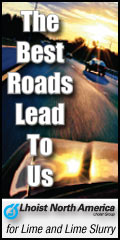News from NAPA
 Print this Article | Send to Colleague Print this Article | Send to Colleague
For accuracy purposes, the entire article below comes from Mike Acott's notice, NAPA's President:
IARC Issues Health Classification
For Occupational Exposures
During Road Paving
Dear NAPA Members and Partners,
The International Agency for Research on Cancer (IARC), based in Lyon, France, issued a statement today assigning occupational exposures to straight-run asphalt cement and its emissions during road paving a Group 2B ("possibly carcinogenic to humans") classification. This Group 2B classification puts road paving in the same category as numerous exposures, including cell phones and coffee.
Dr. Jim Melius, PhD, MD, the top occupational physician at the Laborers International Union of North America (LIUNA), commented, "People working in the asphalt paving industry should not be concerned about this new IARC classification. The two key animal studies on paving asphalt did not show any evidence of cancer risk, and the major IARC cancer study of people working in the paving industry in Europe did not show any increased risk for cancer."
Since questions about the health effects of asphalt fumes were raised in the early 1990s, NAPA has worked in partnership with government agencies, unions, and academic institutions to protect worker health and to answer the scientific questions.
In the process, our achievements have been notable. These include excellent relationships with NIOSH, OSHA, and labor unions. In addition, extensive steps have already been taken to reduce workers' exposure to asphalt fumes via engineering controls and warm mix.
NAPA has developed a PowerPoint presentation designed to answer your workers' questions about the IARC classification. To access the PowerPoint click here.
We believe it is unlikely that you will be contacted by the press; however, in case that does occur, we have developed a list of probable questions and answers for your reference. To access the Q&A click here.
IARC, which brings together international panels of scientists, is based in Lyon, France. Its assessments go to national health agencies for possible guidance. IARC has reviewed more than 900 chemicals and other agents since its founding in 1971. IARC categorizes chemicals, agents, mixtures and exposures into five groups:
Group 1: carcinogenic to humans (includes alcoholic beverages, solar radiation, and wood dust).
Group 2A: probably carcinogenic to humans (includes high-temperature frying, household wood fires, and hairdressing/barber occupational exposures).
Group 2B: possibly carcinogenic to humans (includes coffee and cell phones).
Group 3: not classifiable as to carcinogenicity in humans (includes tea).
Group 4: probably not carcinogenic to humans (only one substance, caprolactam, has been placed by IARC in Group 4).
Again, I am proud to say that the asphalt paving industry has played a proactive role in protecting the health and safety of its workers. These include exposure reductions, process advancements, and partnerships with government agencies and labor unions. And the asphalt paving industry has been recognized for its worker health initiatives.
I was in Lyon and participated in the IARC Monograph process as an official Observer, representing the road paving industry - both U.S. and European. If you have questions about the IARC classification and its possible effect on your business, please feel free to contact me at the NAPA office.
Best regards,
Mike Acott
NAPA President |
|








